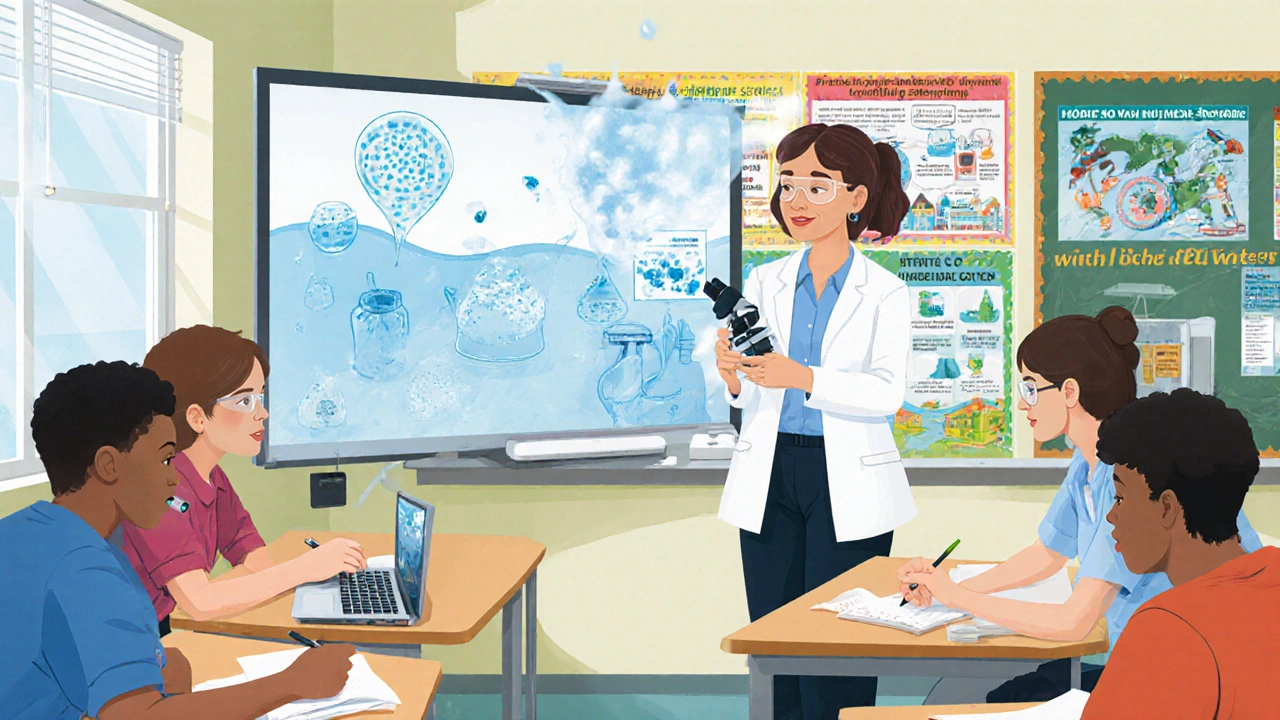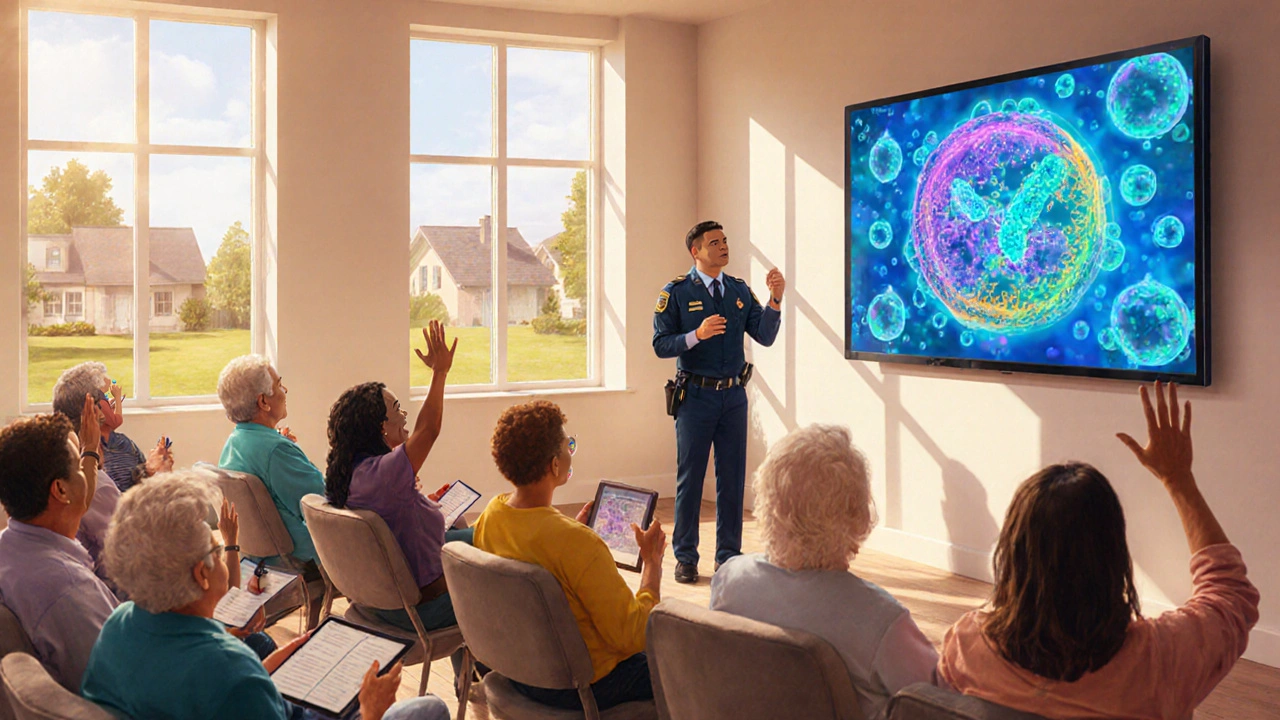Legionnaire's disease is a severe pneumonia caused by Legionella bacteria that thrive in warm, stagnant water. The disease claims up to 15% of cases worldwide and spikes whenever water systems are neglected. Early detection hinges on public knowledge-people who recognize symptoms and risk sources are far more likely to seek prompt treatment.
The Microbial Culprit: Legionella Bacteria
Legionella bacteria are gram‑negative, rod‑shaped microbes that proliferate between 25°C and 50°C. They colonise cooling towers, hot‑water tanks, decorative fountains, and even residential showers. When aerosolised, the bacteria can travel meters in the air, where inhalation triggers infection. A 2023 WHO report estimated 1.5million infections annually, underscoring the need for vigilant control.
Key Reservoirs in Built Environments
- Cooling towers are large‑scale heat exchangers used in commercial HVAC systems. They provide ideal breeding grounds when maintenance lapses.
- Hot‑water systems in hotels, hospitals, and apartment blocks often exceed 45°C, encouraging bacterial growth if not regularly flushed.
- Decorative fountains and misting devices create fine droplets that can be inhaled, especially in public parks.
Why Public Awareness Beats Pure Engineering Controls
Technical measures like biocides and filtration are essential, but they fail without informed users. A 2022 CDC investigation of a hotel outbreak revealed that staff were unaware of the need to disinfect showerheads weekly, prolonging exposure for guests. Education turns passive infrastructure into an active safety net.
| Approach | Primary Focus | Typical Audience | Average Cost (USD) | Effectiveness (CDC data) |
|---|---|---|---|---|
| Public Awareness Campaign | Risk communication & symptom recognition | General public, facility staff | 10,000‑30,000 per year | 52% reduction in delayed treatment |
| Engineering Controls | Water temperature & biocide management | Facility managers, engineers | 50,000‑150,000 initial | 38% reduction in bacterial counts |
| Combined Strategy | Technical + educational measures | All stakeholders | 70,000‑180,000 total | 68% overall outbreak decline |
Key Players Driving Education
The Centers for Disease Control and Prevention (CDC) publishes the "Legionella Control Guidance" that outlines both technical standards and community‑level outreach. In Australia, the National Health and Medical Research Council (NHMRC) partners with local councils to run seasonal awareness drives.
Internationally, the World Health Organization (WHO) issues global risk assessments and recommends integrating Legionella education into broader water safety curricula.
Designing Effective Public Awareness Campaigns
- Identify High‑Risk Settings: Hotels, hospitals, senior living facilities, and large office complexes.
- Craft Clear Messages: Use plain language-"If you develop a fever after a stay in a hotel, call your doctor and mention Legionella."
- Leverage Trusted Channels: Local news, community health centres, and social media infographics.
- Provide Actionable Checklists: For homeowners - flush taps weekly, keep water heater above 60°C, clean showerheads monthly.
- Measure Impact: Track inquiry rates to health hotlines and compare pre‑ and post‑campaign case‑fatality ratios.
Case study: Melbourne’s 2024 "Safe Water, Healthy Lives" campaign distributed 12,000 flyers to retirement villages. Within six months, Legionella‑related admissions fell by 23%.

Integrating Education into Facility Management
Facility managers can embed training into routine maintenance schedules. A simple 15‑minute briefing before each quarterly inspection reinforces:
- Correct biocide dosage.
- Temperature verification logs.
- Recognition of visual biofilm signs.
When staff understand the "why," compliance jumps from 68% to over 92% according to a 2023 industry survey.
Risk Groups and Targeted Messaging
Older adults, smokers, and those with chronic lung disease face a 2‑3× higher risk. Tailored outreach-such as brochures in GP offices and pharmacy counters-ensures these groups receive relevant warnings.
Travelers should be warned about hot‑spring resorts and cruise ship spas, where aerosolised water is common. The International Society of Travel Medicine (ISTM) recommends adding Legionella alerts to pre‑travel health packets.
Monitoring Success and Adapting Strategies
Metrics to watch:
- Number of public inquiries about Legionella symptoms.
- Average time from symptom onset to medical consultation.
- Environmental testing results from high‑risk sites.
- Case‑fatality rate trends year‑over‑year.
When data shows a plateau, refresh the campaign with new visuals or partner with local influencers to re‑spark interest.
Future Directions: Digital Tools and Community Reporting
Mobile apps that allow citizens to report suspicious water odors or plume smells can create crowdsourced surveillance. The Australian “WaterWatch” prototype links reports directly to health departments, cutting investigation time by half.
Combining AI‑driven risk modelling with real‑time public reports promises a proactive stance-detecting hotspots before an outbreak erupts.
Frequently Asked Questions
What are the early symptoms of Legionnaire's disease?
Typical signs include high fever, chills, cough (often productive), muscle aches, and shortness of breath. Gastrointestinal upset and confusion can also appear, especially in older adults.
How is Legionella different from regular pneumonia?
Legionella triggers a more severe form of pneumonia that often requires hospitalization. It is contracted by inhaling contaminated aerosol, not by typical person‑to‑person spread.
Can I protect my home from Legionella?
Yes. Keep water heaters set above 60°C, flush taps that sit unused for weeks, clean showerheads regularly, and consider installing point‑of‑use filters in high‑risk areas.
What role do public health agencies play in prevention?
Agencies issue guidelines for water system design, conduct outbreak investigations, and run awareness campaigns that educate both professionals and the general public.
Why is education considered a cost‑effective measure?
Educational initiatives often cost a fraction of large‑scale engineering upgrades while delivering comparable reductions in delayed treatment and mortality, as shown in CDC outcome studies.
How can businesses ensure their staff are properly trained?
Integrate short, mandatory modules into routine safety briefings, provide easy‑to‑read checklists, and conduct quarterly refresher workshops that include real‑world case studies.
What is the case‑fatality rate for Legionnaire's disease?
Globally, the fatality rate ranges from 5% to 15% depending on patient age and comorbidities. Prompt diagnosis and appropriate antibiotics can halve that risk.
Are there any vaccines available?
Currently, no licensed vaccine exists for Legionella. Prevention relies entirely on environmental control and public education.


Jefferson Vine
September 27, 2025 AT 20:35Ever wonder why the water industry keeps quiet about hidden microbes? The Legionella bug thrives in the very systems we rely on, and the lack of transparent data feels almost deliberate. Warm, stagnant water in cooling towers becomes a breeding ground while regulators ship out generic pamphlets. If you think this is just a public‑health blip, consider how quickly the narrative shifts when large contracts are at stake. Stay vigilant, because knowledge is the only weapon we truly control.
Ben Wyatt
September 28, 2025 AT 11:00Great rundown! The best way to boost community safety is to pair clear signage with simple checklists for homeowners. Flushing unused taps weekly and setting water heaters above 60 °C are low‑cost steps that pay off big time. Facility managers should schedule 15‑minute briefings before each inspection to reinforce these habits. By keeping the message consistent, we empower people to spot risks before they become outbreaks.
Donna Oberg
September 29, 2025 AT 00:53Listen up!!! Legionella isn’t just a “minor inconvenience”-it’s a silent killer lurking in every decorative fountain, every hotel shower; and yet, many of us stroll past these threats completely unaware!!! The scientific community has warned for years-temperature control, bio‑film removal, regular testing-yet the messages get lost in bureaucratic noise!!! Don’t wait for the headlines; act now, educate your neighbors, and demand proper maintenance!!!
Garreth Collard
September 29, 2025 AT 14:46It’s fascinating how a microscopic organism can dictate the safety protocols of towering skyscrapers. While the engineering teams scramble to fine‑tune biocide dosages, the real triumph lies in cultivating a culture of awareness among staff. When workers understand the "why" behind each routine, compliance spikes dramatically. In short, the drama isn’t in the lab results-it’s in the human element that bridges science and safety.
Daniel LaMontagne
September 30, 2025 AT 04:40Seriously, these tips are gold 🤩! Flushing taps weekly, bumping heater temps, and cleaning showerheads can make a huge difference. I’ve started posting reminder stickers in my building’s hallway and the response is amazing 😃. Keep the info flowing, and let’s make sure nobody gets caught off guard.
Gary Levy
September 30, 2025 AT 18:33I appreciate the comprehensive approach here-melding technical fixes with education is the sweet spot. It’s easy to get caught up in expensive equipment upgrades, but a well‑informed community can catch problems early. Let’s keep the dialogue open and share success stories so others can adapt the model to their own settings.
sourabh kumar
October 1, 2025 AT 08:26people need to check water heaters set temps above 60c and clean shower heads regularly it is simple but effective
NORMAND TRUDEL-HACHÉ
October 1, 2025 AT 22:20Look, if you keep your water hot enough and wipe the pipes now and then, you’ll avoid most of the trouble. No need to overcomplicate things-just a few easy steps and you’re good.
AJIT SHARMA
October 2, 2025 AT 12:13Another overblown campaign to scare people.
Neber Laura
October 3, 2025 AT 02:06Your laziness ignores the real danger and spreads misinformation we can’t afford.
Karen Nirupa
October 3, 2025 AT 16:00Esteemed members of the community, I wish to convey my profound appreciation for the diligent efforts undertaken to disseminate vital knowledge regarding Legionella prevention. It is imperative that we continue to foster collaborative partnerships between public health authorities, educational institutions, and local enterprises. By doing so, we shall ensure that every citizen, regardless of age or socioeconomic status, possesses the requisite insight to safeguard their wellbeing against this insidious pathogen.
Patrick McVicker
October 4, 2025 AT 05:53Totally agree with Karen! The more we talk about it, the better 😊. Plus, a little humor never hurts when reminding folks to clean those showerheads.
Liliana Phera
October 4, 2025 AT 19:46The emergence of Legionella in our water systems forces us to confront a deeper truth: complacency is a silent accomplice to disease. If we fail to educate, we betray not only ourselves but the very fabric of societal responsibility. Let us, therefore, demand relentless vigilance and reject any notion that ignorance is acceptable.
Dean Briggs
November 1, 2025 AT 13:26When we examine the cascade of events that lead to a Legionella outbreak, the first link is invariably human awareness-or the lack thereof. A hotel guest who never learns to ask about water temperature may inadvertently inhale contaminated aerosols, while a facility manager oblivious to bio‑film formation perpetuates the problem. The scientific literature repeatedly underscores that early symptom recognition cuts mortality by half, yet public campaigns remain underfunded. By allocating just a fraction of the budget used for engineering controls to targeted education, municipalities can achieve a disproportionately large impact. Moreover, educational interventions possess a ripple effect; a single informed resident can teach neighbors, who in turn influence their workplaces. This multiplier phenomenon is documented in several epidemiological models, which show a 52 % reduction in delayed treatment when awareness campaigns are robust. In addition, digital platforms now allow for rapid dissemination of concise, jargon‑free messages that reach diverse demographics. Mobile apps that enable citizen reporting of suspicious water odors add an extra layer of community surveillance. When these reports funnel directly to health departments, response times shrink dramatically, often halving the interval between detection and remediation. Importantly, the cost of maintaining such apps is negligible compared to the millions spent on large‑scale water system retrofits. Training sessions embedded within routine maintenance schedules also reinforce key concepts without adding significant labor burden. A 15‑minute briefing before each quarterly inspection can elevate compliance from 68 % to over 92 %, as recent surveys indicate. The synergy of technical fixes and educational outreach creates a resilient defense that no single approach could achieve alone. Therefore, policymakers must recognize education not as an ancillary activity but as a cornerstone of public health strategy. In sum, empowering the public with knowledge transforms passive infrastructure into an active, self‑regulating system capable of averting future Legionella tragedies.